
Even regular poker players often have strange interpretations of statistics. For example, that the opponent is barreling frequently and will therefore choose a c/raise line with a value hand. This may be an intuitive decision to reduce the opponent's aggression, but from a statistical point of view, the choice of such a line will usually be wrong. These interpretations probably mostly come from a rather blunt understanding of exactly what the HUDs reflect and the tendency of the player in one way or another.
To improve their understanding of the game based on statistics, each player should first do some preparatory work:
- Understand the trends in your playing limit and format. Player styles will vary greatly between NL2 and NL100, so applying blind "good player" parameters to everyone is rather futile. Players in the NL2 limit are much less likely to have balanced 3bet ranges than NL100 regs, so it will often be up to them to adapt their style to the trends.
- At least a rough idea of a solid player's stats and rank. The range can often be determined from the available preflop tables, and then changed slightly by adding or subtracting hands according to trends.
- Understand what parts of the rank are represented by certain hand combinations. For example, what percentage of the total range is made up of broadway, Ax, pocket pair hands. This knowledge can be very easily gained by using Equilab and analysing the above mentioned parts of the range. The most important way to apply this knowledge is to think about the possible parts of the range postflop, especially when playing more complex pots (3bet/4bet).
Of course, statistical knowledge needs to be continually expanded and deepened to improve in this field, but before any interpretation can be made, there needs to be a basis of understanding. Using this foundation, we can ask ourselves the right questions about the opponent's statistics and potential play.
One of the main mistakes that players make is to consider only one statistical unit. For example, we see that the opponent's 3bet is much higher than the average player in that limit. In this case, the optimal choice must be determined not only by the frequency of 3bet, but also by other factors of the style of play (postflop stats, 3bet fold, etc.). Knowing the opponent's postflop playing style will allow us to make an informed choice of which hands to call and which to 4bet.
Of course, it is not necessary to look at absolutely every single piece of data displayed by the HUD, as sometimes the optimal solutions will be found just by looking at a few key pieces of data, such as cbet frequency or folding frequency. For example, we are playing HUSNG against one of two players. In the first one, the cbet flop is 95% and remains similar on the turn and river. The second flop cbet is 35% and remains similar to the turn and river. We know that the player hits the flop on average one third of the time.
How to make the most of both? In the first case, we would like to reduce the use of c/raise in strong hands, as there will be a lot of bluffs in the opponent's range, and we don't want to throw them away. We can extend our three-way calling range with a little more marginal made hand'aisas the opponent is less likely to have something strong (with some margin, of course). In the second case, we will want to narrow our calling range somewhat, and choose c/raise bluffing lines less often.
The general trend may be:
- As the opponent's aggressive stats (ISO, 3bet, cbet, etc.) increase, we'll want to play more value and less bluffing.
- As the aggressive stats decrease, we will want to narrow our calling range and choose our bluffing spots more carefully.
Of course, these are just perfectly simple examples. Other choices are possible to accommodate each approach, but optimal solutions can only emerge when we have a game theoretical understanding. The easiest way to get started on the right track is to ask yourself every time "what does this say about the opponent's rank?" If we have a good theoretical background, the answer to this simple question will give us many possible answers. You can find the rationale for the importance of theory in this video by Paul Zulonas:
Smart Poker - all the things that matter but are ignored (cash games)





